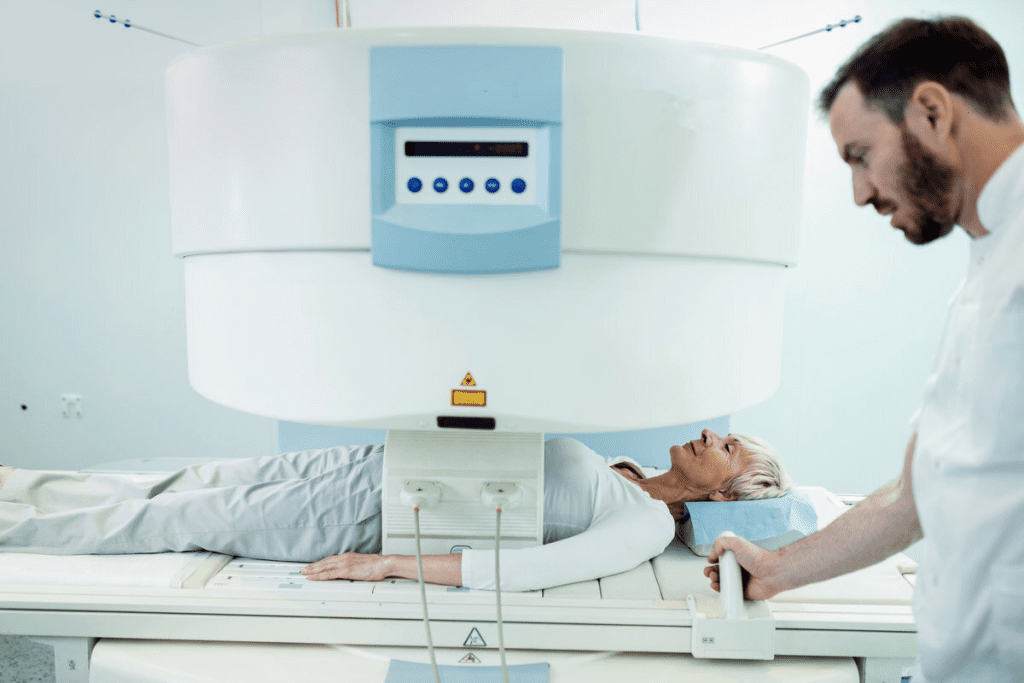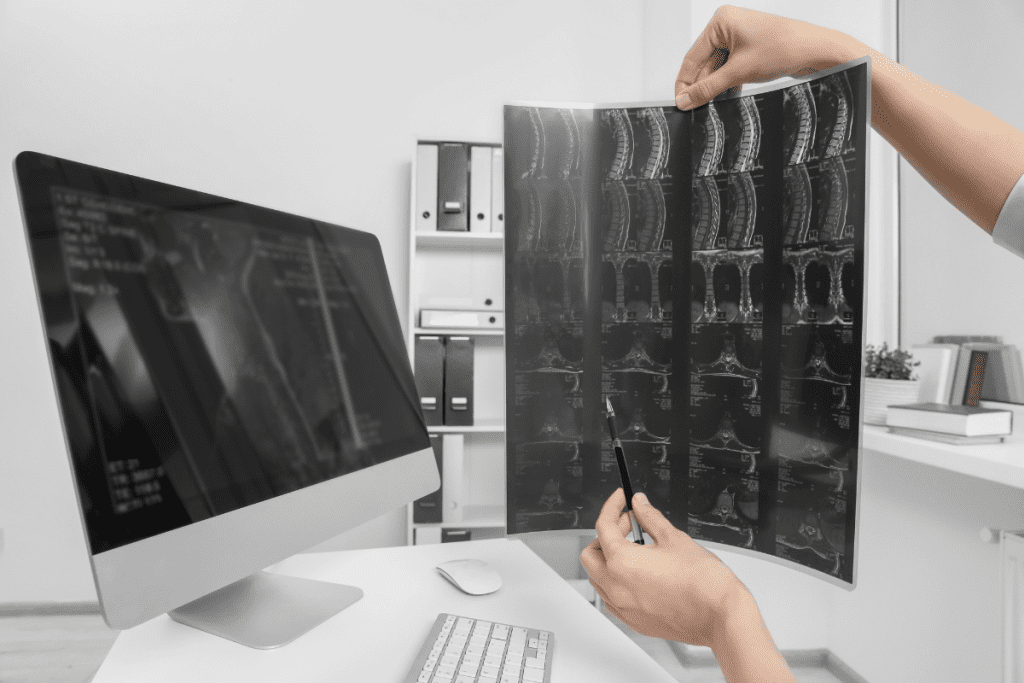Last Updated on November 25, 2025 by

We are always finding new ways to detect and manage prostate cancer diagnosis. Multiparametric MRI (mpMRI) is a key tool in this effort. MRI scans use radio waves and strong magnets to create detailed images of soft tissues in the body. This helps doctors see the prostate and nearby areas clearly.
With mpMRI, we can spot important prostate tumors better than before. This advanced imaging has transformed the process of prostate cancer diagnosis. It allows us to provide more focused care and cut down on unnecessary tests.
MRI has changed how we find and treat prostate cancer. Thanks to new MRI tech, we can now diagnose and treat prostate cancer better than before.
Multiparametric MRI is a big leap forward. It checks how water moves and blood flows in the prostate. This helps us see if cancer is there and how serious it is. Studies show it can spot cancer well, with a high chance of being right.
Multiparametric MRI uses different imaging methods to look at the prostate. It looks at T2-weighted, diffusion-weighted, and dynamic contrast-enhanced imaging. This gives a clearer picture than old methods.
The process includes:

More doctors are using MRI to find prostate cancer. It’s gone from 3.8% to 32.6%. This shows MRI is really good at finding cancer.
As MRI tech gets better, it will be used even more. It helps find cancer accurately, cuts down on biopsies, and improves patient care.
MRI is now a key tool for finding prostate cancer. It’s very accurate and can spot serious cancer. This means patients with clear scans are likely cancer-free.
The main benefits of MRI for prostate cancer are:
As we keep improving in oncology, MRI will be even more vital for prostate cancer.
MRI technology has changed how we diagnose prostate cancer. It has helped 41% of men avoid unnecessary biopsies. This shows MRI’s big win in prostate cancer diagnosis.
MRI gives a clear view of the prostate gland. It spots suspicious lesions that other methods miss. This is key for accurate diagnosis and treatment plans.
PSA testing helps find prostate cancer, but has its limits. It can give false positives and negatives. MRI, though, offers more detailed info than PSA testing alone. This makes it more accurate for diagnosis.
Understanding psa blood test meaning and psa test results can be tricky. MRI makes these clearer.

MRI can skip the need for an immediate biopsy. This lowers the risk of complications and discomfort from invasive tests. MRI gives a clearer view of the prostate, helping doctors decide if a biopsy is needed.
MRI is great at telling aggressive from non-aggressive cancers. Knowing this is key to the right treatment plan. A study shows MRI helps find who needs more aggressive treatment.
In short, MRI beats traditional methods in many ways. It offers better visualization, accuracy, less invasiveness, and better cancer type differentiation. Using MRI in diagnosis means better, more tailored care for patients.
MRI has changed how we diagnose prostate cancer, making it more precise. We can now find and treat prostate cancer better than before. This is thanks to new MRI technology.
MRI’s high negative predictive value (NPV) of 96% is a big plus. It means a 96% chance that a negative MRI scan means no significant prostate cancer. This reassurance helps avoid unnecessary tests and treatments.
For example, a patient with a negative MRI scan is likely not to have aggressive cancer. This means they can skip the discomfort and risks of biopsies. The high NPV is a game-changer in diagnosing prostate cancer, leading to more tailored and less invasive treatments.
Studies show MRI can find clinically significant prostate cancer in 24-29% of cases. This is a big leap forward from older methods that often miss aggressive cancers.
MRI’s ability to spot significant cancer early is key. It helps doctors treat cancer quickly, ensuring patients get the right care on time.
The PI-RADS scoring system helps doctors estimate the chance of prostate cancer from MRI scans. A high score means a higher chance of cancer, guiding treatment decisions.
Knowing the PI-RADS system is important for doctors and patients. It helps everyone understand MRI results in a clear way, making sure doctors agree on what to do next.
Even with its benefits, MRI has its downsides. It can miss cancer, leading to false negatives. It’s key for both doctors and patients to know about these risks and use other tests when needed.
By understanding these risks, we can work to reduce them. This includes improving MRI tech and using it with other tests to get even better results.
Adding MRI to the prostate cancer diagnosis process brings many benefits. The Prostate-Specific Antigen (PSA) blood test is often used first. But it’s not always clear and can cause worry and extra tests. MRI gives more precise results, cutting down on the need for more tests and giving patients clearer answers.
Using MRI for prostate cancer diagnosis can lower the number of biopsies needed. Studies show MRI can skip biopsies for many patients. This means fewer risks and less discomfort for those who don’t have serious cancer.
Men with negative MRI scans are less likely to have serious cancer. Research says 62% to 64% of them can skip biopsies. This makes the process less stressful and avoids the wait for biopsy results.
Getting a clear diagnosis can ease a patient’s mind. MRI gives clearer results than PSA tests alone. This helps patients feel more sure about their diagnosis and treatment plan.
Using MRI in diagnosis can also save money. It cuts down on unnecessary biopsies and gives more accurate results. This makes the whole process cheaper for patients and healthcare systems.
In summary, MRI in prostate cancer diagnosis has many benefits. It reduces unnecessary biopsies, lets some men avoid biopsies, offers clearer results, and saves money. As we improve prostate cancer diagnosis, MRI’s role will grow even more important.
We’ll walk you through the MRI prostate cancer screening process. You’ll know what to expect at each step. This will help ease your worries and get you ready for the test.
Before your MRI, there are steps to take. Following your doctor’s instructions is key to a good outcome. You might need to change your diet, avoid certain meds, and arrive early to fill out forms.
Also, tell your doctor about any metal implants, pacemakers, or health issues. This info is vital for your safety during the scan.
During the MRI, you’ll lie on a table that slides into the machine. The scan is usually painless, but some might feel a bit uncomfortable or anxious. Our team is ready to make you as comfortable as possible.
The MRI machine makes loud noises. You’ll get earplugs or headphones to block out the sound. It’s important to stay very quiet during the scan for clear images.
After the MRI, your doctor will look at the images and talk to you about them. A radiologist will check the scans for any signs of cancer.
Waiting for results can be tough. Our team will help you through the next steps, like more tests or talking about treatment.
Sometimes, more tests are needed after an MRI. This could be a biopsy or other tests. Your doctor will explain why and what to expect.
It’s important to follow your doctor’s advice for an accurate diagnosis and treatment. We’re here to support you every step of the way.
Advanced imaging, like MRI, is changing how we find and treat prostate cancer. MRI can spot serious prostate cancer more often than traditional biopsies. It finds 38% of cases, while biopsies find 26%. This shows MRI’s power in finding cancer early.
The role of MRI in finding prostate cancer is huge. It can see if cancer has spread beyond the prostate and if it comes back. MRI is very good at this, with a 59% sensitivity and 69% specificity. For more on MRI’s role, check out the National Center for Biotechnology Information.
Looking ahead, MRI will keep being key in fighting prostate cancer. It helps doctors make accurate diagnoses and avoid too many biopsies. As MRI tech gets better, it will help find cancer even sooner. This means better treatments and care for patients.
MRI is key in finding serious prostate tumors. It shows tumors better than blood tests alone. This makes it a top choice for doctors.
Multiparametric MRI uses different imaging methods. It gives clear pictures of the prostate. This helps doctors spot and understand tumors better.
MRI helps avoid too many biopsies. It lets doctors skip biopsies if scans are clear. This brings relief and saves money in the long run.
MRI is very good at ruling out serious cancer. It misses only about 4% of serious cases. It finds significant cancer in 24-29% of men.
The PI-RADS system helps doctors understand MRI results. It shows how likely it is that cancer is serious based on the scan.
Before the MRI, you’ll need to prepare. During the scan, you’ll get a non-invasive test. After, your doctor will talk about the results and might suggest more tests.
No, MRI doesn’t replace PSA testing. It’s used with PSA and other tests for a full check-up.
MRI use has grown a lot. It’s now used in 32.6% of cases, up from 3.8%. Its benefits are now widely accepted.
MRI shows tumors better and is more accurate. It helps tell aggressive from non-aggressive cancers. This means fewer unnecessary biopsies and clearer results.
Subscribe to our e-newsletter to stay informed about the latest innovations in the world of health and exclusive offers!